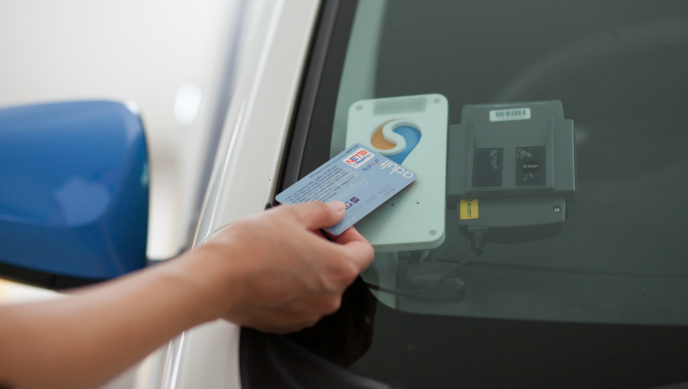Smove is a car-sharing network with over 400 vehicles in 110-plus locations across Singapore

Smove’s Chief Commercial Officer Joseph Ting
The startup was running out of cash. The founders hadn’t drawn a salary for months. Some ended up sleeping in the office for weeks. There were no clear answers ahead and no light at the end of the tunnel.
However, they didn’t give up. They clung to their idea because they knew if they wanted something, the whole universe would conspire to make it happen.
And it happened.
Here is the success story of Smove, an online car-sharing platform in Singapore.
Quitting high-profile job
After obtaining a Bachelor of Business Management (Finance) degree from Singapore Management University, Jospeh Ting went on to work in different countries in Asia, including India and China. However, in 2013, after a three-year stint with Singapore Airlines, he decided it was time to experience a move away from the big company bureaucracy and try the startup scene.
“At that point of time, startups were not as common as they are today, and my mentality then was that I was still young and had room to try and fail,” Ting tells e27. “Smove is the culmination of this experiment.”
Started in 2013 by Tom Lokenvitz (CEO), James Lam (COO), and Ting (CCO), Smove is a car-sharing network with over 400 vehicles in 110-plus locations around Singapore. It operates on a free floating service, which means customers can pick up a vehicle from point A, drive to his/her destination, and drop off the vehicle at any of Smove’s designated drop-off points.
“Unlike most car sharing companies, whose vehicles must be returned to where they were picked up from, our fleet has the ability to move to high utilisation areas, ultimately benefiting the customers by optimising vehicle availability and ease of usage,” he boasts.
All the cars have the push-to-start button, so it is completely keyless. Users can use their EZLink card to lock and unlock the car.
The ignition
“When I was looking for a break from the corporate world, I sensed that shared mobility was the future. However, the startup scene wasn’t as established as it is today. Coupled with that, the sharing economy was in its infancy, so one major challenge was that we had to create our own business model without any playbooks or templates,” he recounts the story for e27. “The way we overcame these challenges along the way was through improvisation, bootstrapping, and the ability to quickly test and learn from these iterative experiments.”
Also Read: Infightings, quitting of key people didn’t deter this entrepreneur from realising his dream
The startup was originally called Clean Mobility Singapore, which, however, didn’t quite roll off the tongue. The name ‘Smove’ was suggested by an ex-intern and it struck a chord with the founders. “Smove is an abbreviation of ‘Singapore move’. The word also stands for ‘smart move’,” he says.
With a noble vision to make cities more liveable by improving the way people move, Smove started off with electric vehicles. “Although this vision still exists today, we quickly realised in 2014 that electric vehicles at that point of time wasn’t sustainable as the infrastructure wasn’t available in Singapore to adequately support our service. So we pivoted to petrol engine cars in 2015 and have grown our fleet size to over 400 vehicles offering consumers a choice of Toyota Aquas to BMWs,” Ting adds.
“Looking ahead, we do hope to return to our roots and offer electric vehicles as an option to our customers, as we increasingly see opportunities and sufficient support infrastructure,” continues Ting.
A one-man show
In the early days, Smove had only four team members and six electric cars in a small area in Singapore. It was a one-man show, says Ting, as he had to manage the operations and business development himself (he had to clean, fix and maintain the cars while trying to grow the network of locations around Singapore).
“Those were the days when we were literally working round the clock. Then we hit a critical turning point when we realised we had to pivot from electric cars in order to expand further. The pivot was challenging as we nearly went bankrupt during the period, and we went without pay for months while racing against time to make things work,” Ting details his roller-coaster journey.

After that, the team had a crazy scale-up period when the company signed a formal partnership with Uber and started expanding rapidly. There were very sharp growing pains in growing so quickly, he mentions, as the fleet went from 20 cars to 200 in less than six months, and the staff strength increased five-fold.
“We had to learn and adapt very quickly, making many mistakes along the way, but learning many invaluable lessons. Fast forward to today, our business is still growing and changing and I think we are still far from saying that we’ve arrived,” he smiles.
Smove is targeting anyone with a valid driving licence. It has two specific use cases – private hire drivers and private consumer use. This means its ideal customer ranges from millennials with young children, young working adults all the way to retirees who have sold their cars.
So far, the startup has raised US$1.3 million from Wavemaker Partners and Rebright Partners for team expansion and in-house technology development. In Ting’s opinion, funding is extremely important, but it’s not a case of “more the better”.
On the move
Singapore is a unique market as public transport is affordable and reliable. However, Ting still sees massive opportunities in the traditional car rental industry. “One key opportunity includes moving towards a platform as a service to increase utilisation of traditional fleet operators. We’re also looking at shorter term rentals as a viable alternative to taxis, as well as exploring other modes of transport.”
“We’re constantly on the lookout for expansions into cities that would be conducive for our service to thrive in. Some potential markets would include Malaysia, Indonesia, and the Philippines to name a few,” he adds.
Talking about VC investment industry in Singapore, he asserts: “Obviously, when you do not have enough funding, the business will not be able to grow and scale and cashflow overshadows all other business growth opportunities. However, if you have too much money, it presents other problems too. Companies grow in an unsustainable way and pursue growth at all costs.

When the rooster comes home to roost and the day comes when you need to become a profitable and sustainable business, these companies will experience huge difficulties in restructuring for profitability. In a sense, they become dependent on fundraising indefinitely without having ever proved their business model,” Ting remarks.
According to Ting, talent shortage, hiring, and funding are the key challenges entrepreneurs in Singapore are facing today.
“There is generally a lack of risk-taking mindset in society which hampers the ability of very young startups to hire talent. When it comes to funding, the scene in Singapore is not as developed compared to the US. VCs and investors here are more conservative and demanding. Funding rounds are generally smaller and startups need to demonstrate a very clear path to sustainability. Unless you reach unicorn status, it will be very unlikely a startup can raise money indefinitely. Investors will call you to account much sooner.”
Market size and diversity are the other two major problems. Says Ting: “The Singapore market is developed but small, compared to other markets in the region. It means startups here need to expand regionally in a short time in order to scale. This is made more challenging by the fact that Southeast Asia is a very diverse market and it’s not as easy to ‘plug and play’ a business model.”
“This is a challenge that startups in the US don’t face. They can grow to billion-dollar companies without having to expand overseas. Startups in Singapore need to expand to multiple countries in Asia to achieve a similar valuation,” he signs off.
The post ‘With no salary for months, founders had to sleep in the office’: How Smove built a successful business from scratch appeared first on e27.